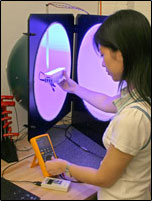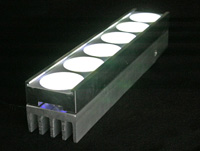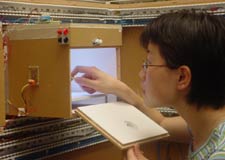

White LED fixture packaging studies

New white LED packaging design (SPE) for improved performance

LED life and light output degradation studies
|
High-Efficiency, Nitride-Based Solid-State Lighting
Many industry experts are optimistic that solid-state lighting technology, particularly the light-emitting diode (LED), will revolutionize architectural lighting. However, problems with low lumen output and low system efficiency must be resolved before general illumination with LEDs can become a reality. Nearly two-thirds of the photons generated by an LED are trapped within the device where they are absorbed and converted into heat, reducing LED performance. Packaging LEDs into fixtures that are acceptable for architectural lighting is also a challenge. Packaging designs must consider the heat dissipation needs of LEDs while meeting architectural design requirements.
Researchers at the University of California at Santa Barbara (UCSB) and the Lighting Research Center (LRC) spent three years developing a high luminous efficacy white solid-state light source, through a U.S. Department of Energy project entitled "High-Efficiency Nitride-Based Solid-State Lighting." The project team explored the fundamental issues associated with nitride-based LEDs, the foundation of solid-state white light. The overall goal of the project was to achieve 200 lumens per watt (lm/W) from this light source, along with good color properties and long life.
Dr. Shuji Nakamura, who developed the world's first gallium nitride (GaN) LED, led the UCSB team, which focused on resonant cavity light-emitting structures. The LRC team, led by Director of Research Dr. N. Narendran, focused on challenges in packaging, testing and evaluation of nitride-based solid-state lighting. The LRC's work included:
- developing the subcomponents necessary for packaging UCSB’s semiconductor light emitters
- benchmarking the performance of current LED devices
- defining specifications for the new light source through human factors studies
- developing epoxy materials to encapsulate the semiconductor element (with Rensselaer's Chemistry group)
- integrating UCSB's device with optics and electronic controls for general illumination applications
SUMMARY OF UCSB RESEARCH
The UCSB team initially pursued the development of blue gallium nitride (GaN)-based vertical-cavity surface-emitting lasers, as well as ultraviolet GaN-based LEDs. In Year 2, the emphasis shifted to resonant-cavity light-emitting diodes, also known as micro-cavity LEDs when extremely thin device cavities are fabricated. These devices have very directional emission and higher light extraction efficiency than conventional LEDs. Via the optimization of thin-film growth and refinement of device processing, UCSB decreased the total cavity thickness to less than 1 µm, such that micro-cavity effects were clearly observed and a light extraction efficiency of over 10% was reached. UCSB also began the development of photonic crystals for increased light extraction, in particular for so-called ‘guided modes’ which would otherwise propagate laterally in the device and be re-absorbed. Finally, UCSB pursued the growth of smooth, high-quality nonpolar a-plane and m-plane GaN films, as well as blue light-emitting diodes on these novel films. Initial nonpolar LEDs showed the expected behavior of negligible peak wavelength shift with increasing drive current. M-plane LEDs in particular show promise, as unpackaged devices had unsaturated optical output power of ~ 3 mW at 200 mA drive current.
SUMMARY OF LRC RESEARCH
At the conclusion of this project, the LRC demonstrated a new packaging method, called scattered photon extraction (SPE), that produced an average luminous flux and corresponding average efficacy of 90.7 lm and 36.3 lm/W, respectively, compared with 56.5 lm and 22.6 lm/W for a similar commercial white LED package. At low currents, the SPE package showed over 80 lm/W white light with chromaticity values very close to the blackbody locus. The SPE package showed an overall improvement of 61% for this particular comparison, exceeding the LRC’s third-year goal of 25% improvement. Human factors studies of light source form for general illumination showed that UCSB’s RCLEDs are best suited for downlight fixtures, in terms of comfort and visual clarity. Rensselaer’s Chemistry group developed new die encapsulant materials using silicone-epoxy resins. The devised materials show slower degradation and less yellowing than materials used in commercially available epoxy encapsulants. Finally, three years of life-testing to benchmark the performance of commercially available LEDs indicate that the single-die white LEDs tested will maintain 70% of their initial light output at 45,000 hours with only a small color shift over time. With the collected benchmarking data, the LRC has begun to develop a life prediction metric for white LEDs. Experiments showed that the LED degradation rate changes as a function of junction temperature depending on the source of increasing heat (drive current or ambient heat). The source of increasing heat also affects 5-mm and high-flux LEDs differently. Once a life predictor can be quantified, the LED life of a system can be estimated without long-term life testing — a significant benefit when developing new LED packages.
PROJECT LINKS
Final Project Report to U.S. Department of Energy
For summaries of some of the studies and experiments conducted through this project, visit the folllowing links:
LRC PROJECT-RELATED TECHNICAL PAPERS
Narendran, N. 2005. Improved performance white LED. Fifth International Conference on Solid State Lighting, Proceedings of SPIE 5941: 45-50.
Full-text PDF
Narendran, N. and Y. Gu. 2005. Life of LED-based white light sources. IEEE/OSA Journal of Display Technology 1(1): 167-171.
Full-text PDF
Narendran, N., Y. Gu, J.P. Freyssinier-Nova, and Y. Zhu. 2005. Extracting phosphor-scattered photons to improve white LED efficiency. phys. stat. sol. (a) 202 (6): R60-R62.
Journal Abstract
Gu, Y., and N. Narendran. 2004. A non-contact method for determining junction temperature of phosphor-converted white LEDs. Third International Conference on Solid State Lighting, Proceedings of SPIE 5187: 107-114.
Summary | Full-text PDF
Gu, Y., N. Narendran, and J.P. Freyssinier. 2004. White LED performance. Fourth International Conference on Solid State Lighting, Proceedings of SPIE 5530, eds. I.T. Ferguson, N. Narendran, S.P. DenBaars, J.C. Carrano, 119-124. Bellingham, WA: International Society of Optical Engineers.
Full-text PDF
Narendran, N., L. Deng, R.M. Pysar, Y. Gu, and H. Yu. 2004. Performance characteristics of high-power light-emitting diodes. Third International Conference on Solid State Lighting, Proceedings of SPIE 5187: 267-275.
Summary | Full-text PDF
Narendran, N., Y. Gu, J.P. Freyssinier, H. Yu, and L. Deng. 2004. Solid-state lighting: Failure analysis of white LEDs. Journal of Crystal Growth 268 (3-4): 449-456.
Full-text PDF
Narendran, N., Y. Gu, and R. Hosseinzadeh. 2004. Estimating junction temperature of high-flux white LEDs. In Light-emitting diodes: Research, manufacturing, and applications VIII, Proceedings of SPIE 5366, eds. S.A. Stockman, H.W. Yao, E.F. Schubert, 158-160. Bellingham, WA: International Society of Optical Engineers.
Full-text PDF
Taylor, J. 2003. Non-intrusive techniques help to predict the lifetime of LED lighting systems. Compound Semiconductor, October: 27-30.
Full-text HTML (Requires free site registration)
SPONSORS
United States Department of Energy
Cooperative Agreement No. DE-FC26-01NT41203
University of California at Santa Barbara
|


